Abstract
1. Methods are described whereby the soleus muscle of the rat may be used for the investigation of initial processes in the absence of oxidative recovery. 2. The anaerobic conditions employed had no effect on the concentration of phosphocreatine in resting muscle or the mechanical response during contraction. 3. Muscles were stimulated tetanically for 10 s at 17-18 degrees C. Measurements were made of the heat production and metabolic changes that occurred during a 13 s period following the first stimulus. 4. There was no detectable change in the concentration of ATP. Neither was there detectable activity of adenylate kinase or adenylate deaminase. The changes in the concentration of glycolytic intermediaries were undetectable or very small. 5. The change in the concentration of phosphocreatine was large and amounted to -127 +/- 11-4 mumol/mmol Ct (mean and S.E. of the mean, negative sign indicates break-down, Ct = free creatine + phosphocreatine) which is equivalent to about -2-13 mumol/g wet weight of muscle. The heat production was 6549 +/- 408 mJ/mmol Ct (mean and S.E. of mean) which is equivalent to about 110 mJ/g. 6. About 30% of the observed energy output is unaccounted for by measured metabolic changes. 7. The ratio of heat production (corrected for small amounts of glycolytic activity) to phosphocreatine hydrolysis was -49-7 +/- 5-6 kJ/mol (mean and S.E. of mean), in agreement with previous results using comparable contractions of frog muscle, but different from the enthalpy change associated with phosphocreatine hydrolysis under in vivo conditions (-34 kJ/mol). 8. The results support the notion that the discrepancy between energy output and metabolism is an indication of an unidentified process of substantial energetic significance that is common to a number of species.
Full text
PDF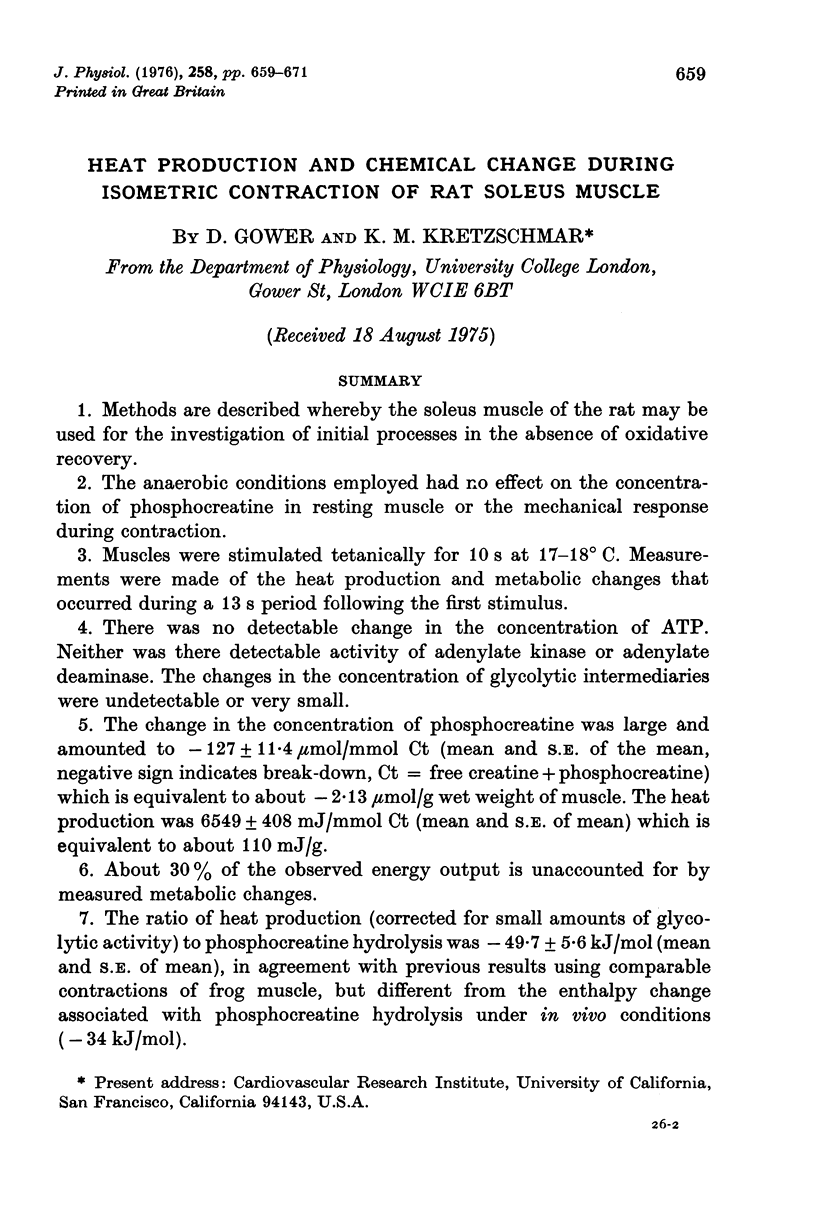

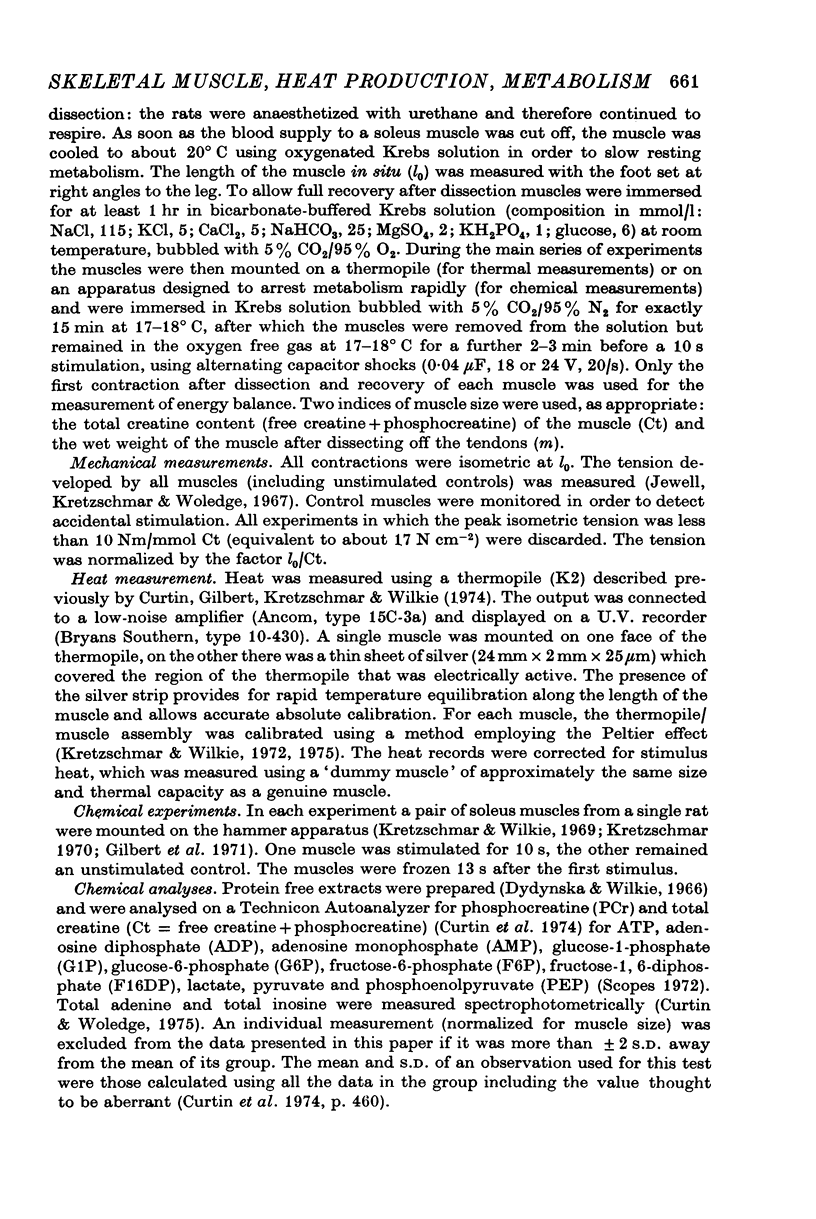
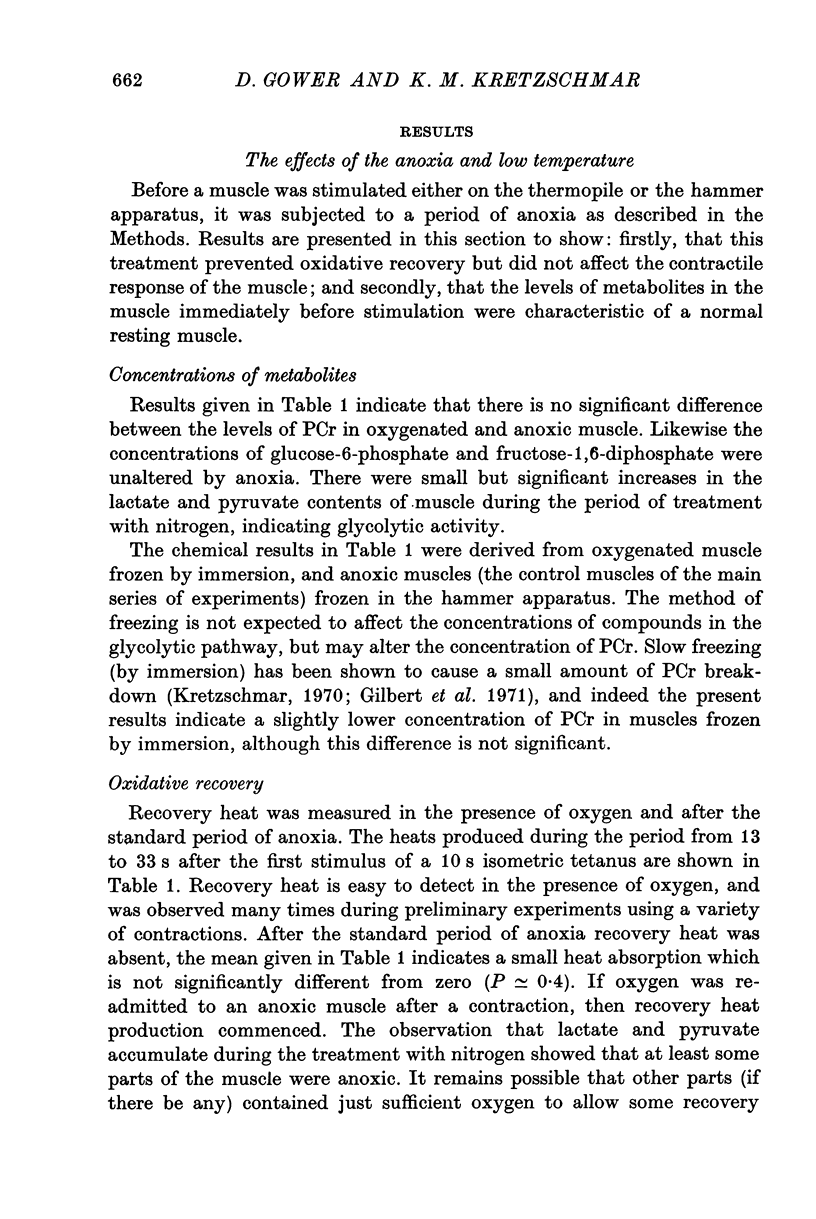

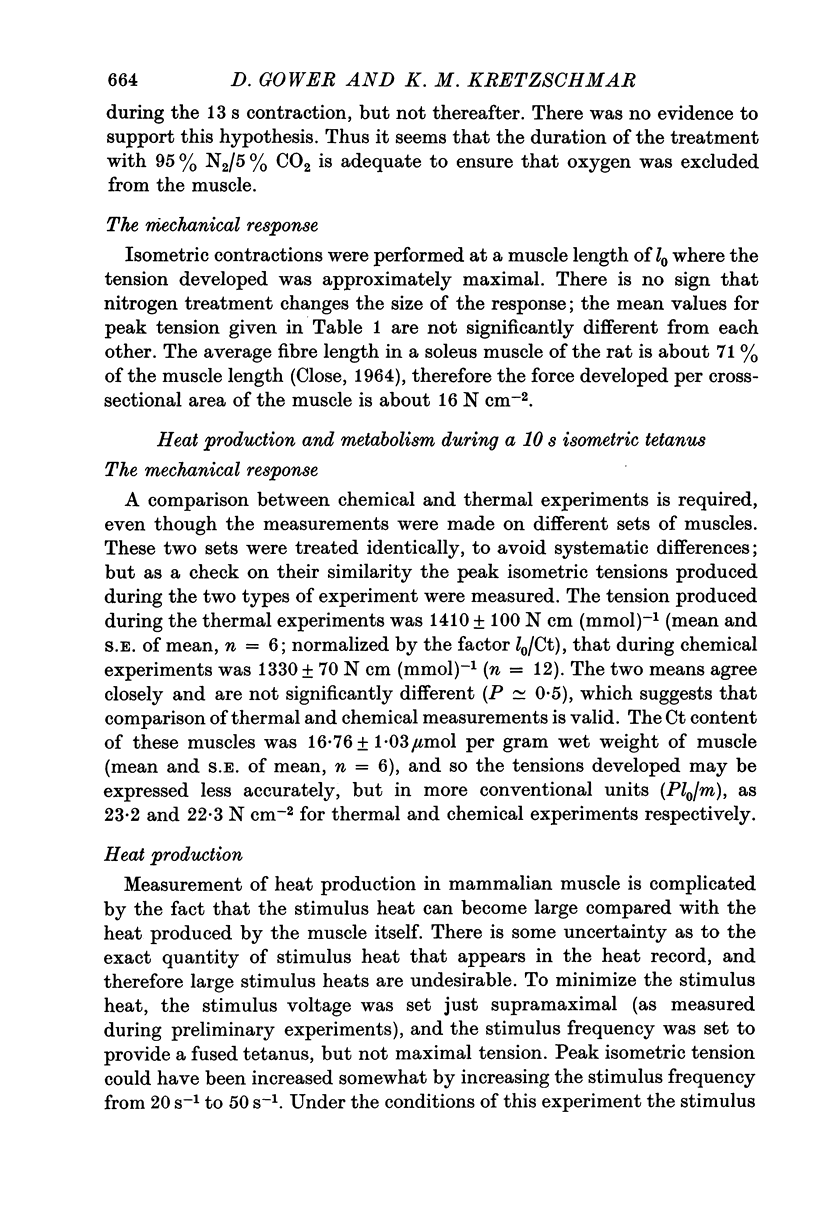
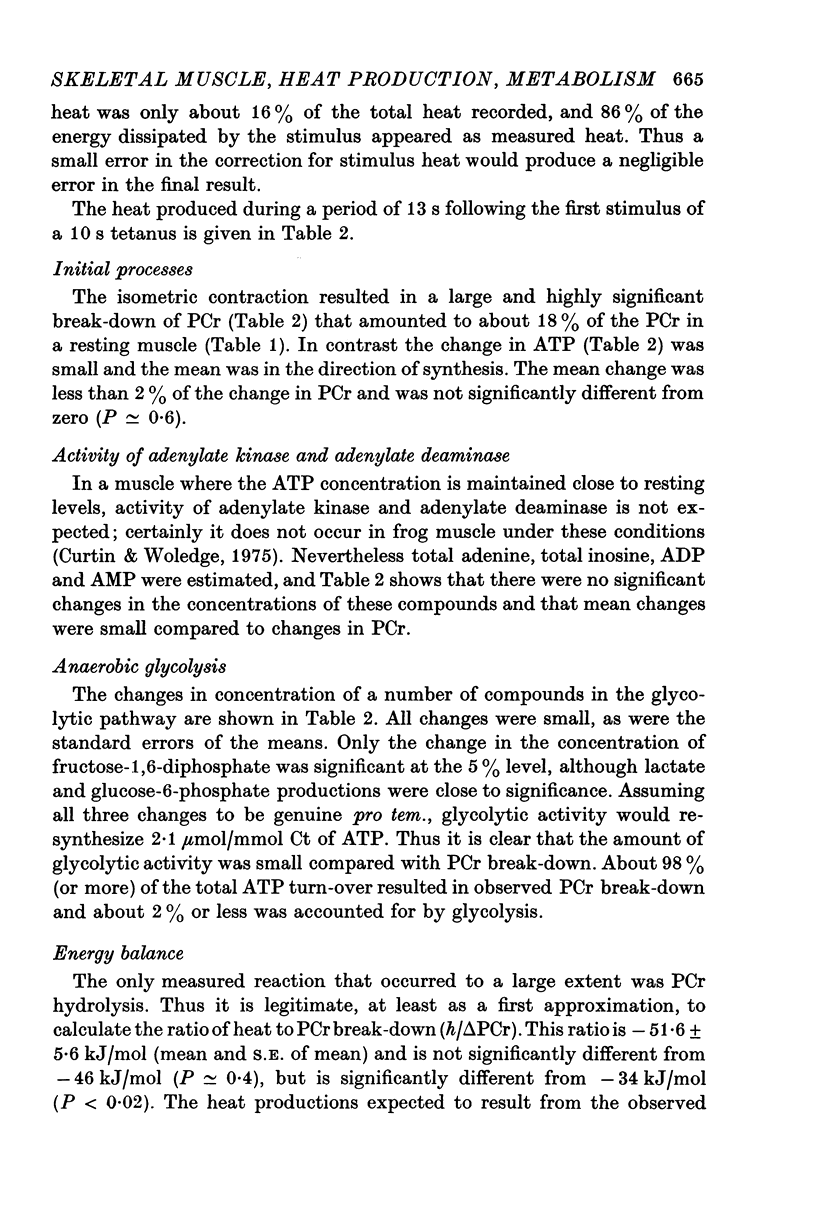
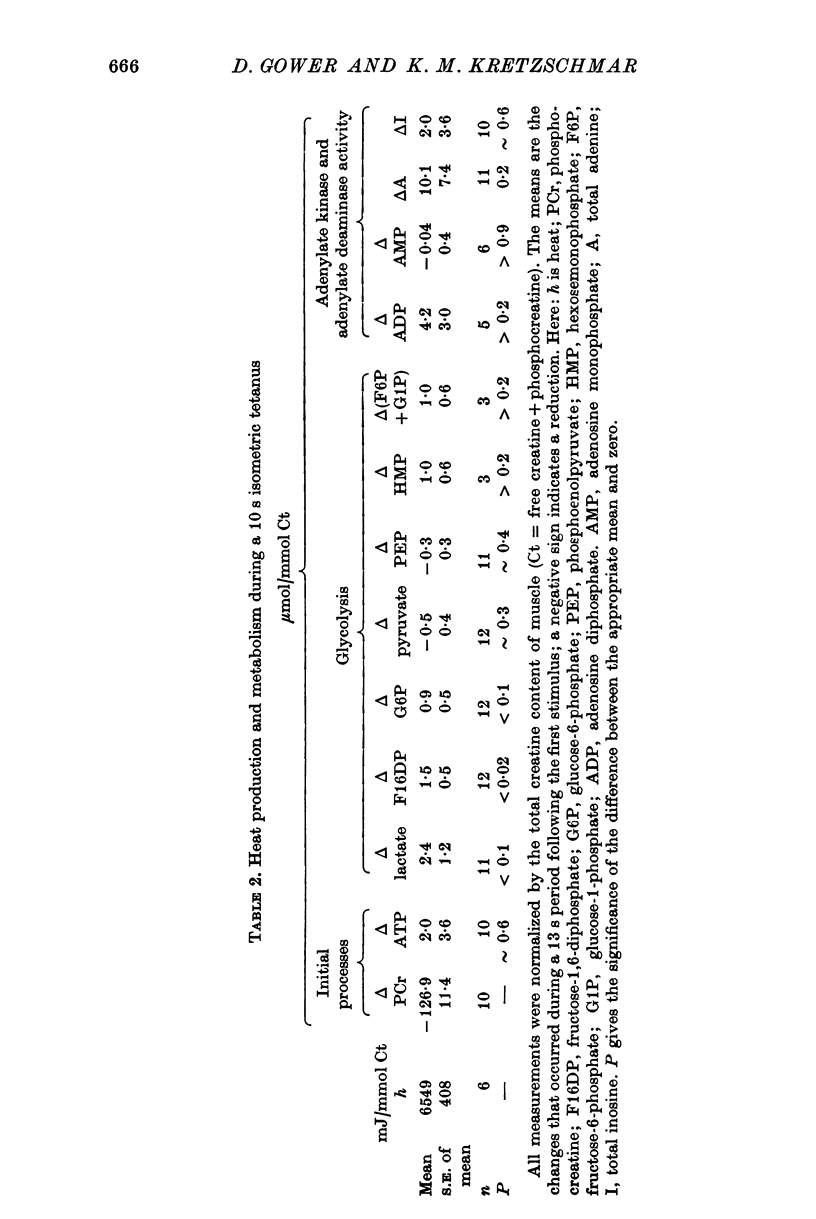
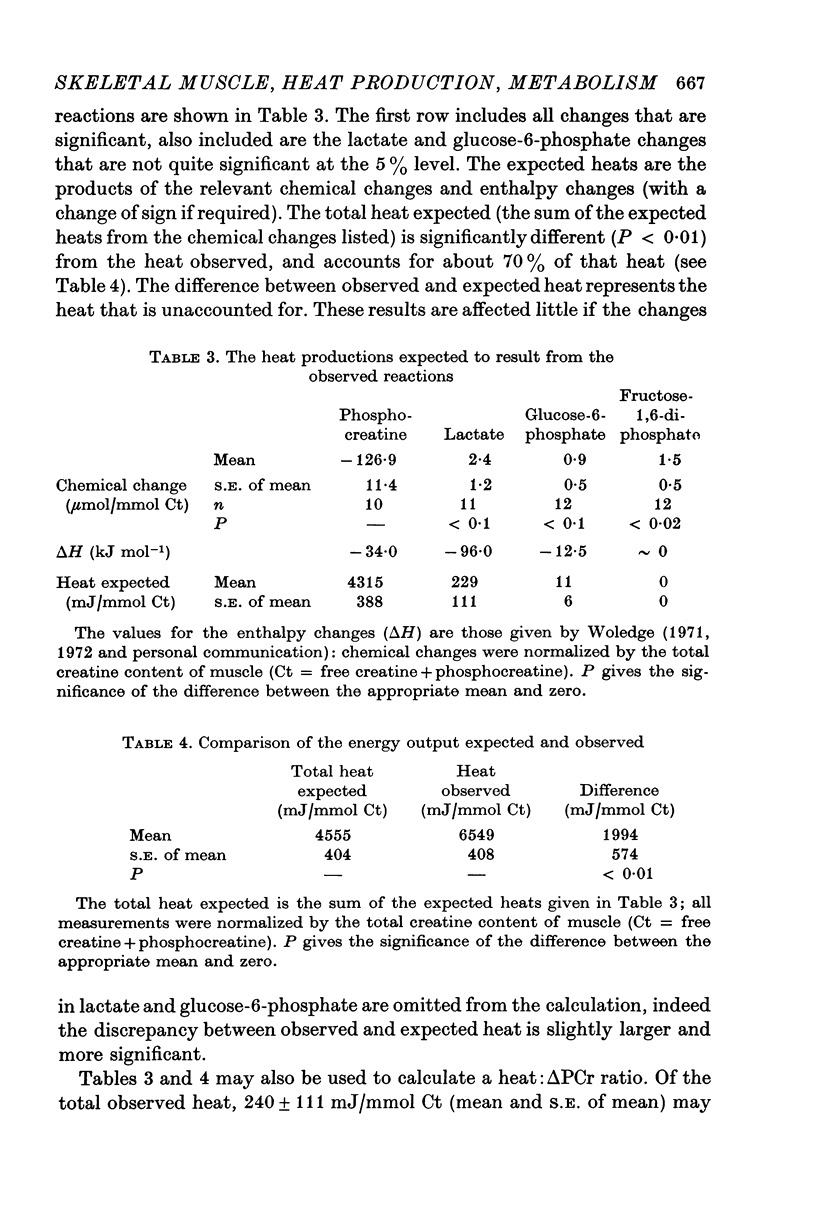
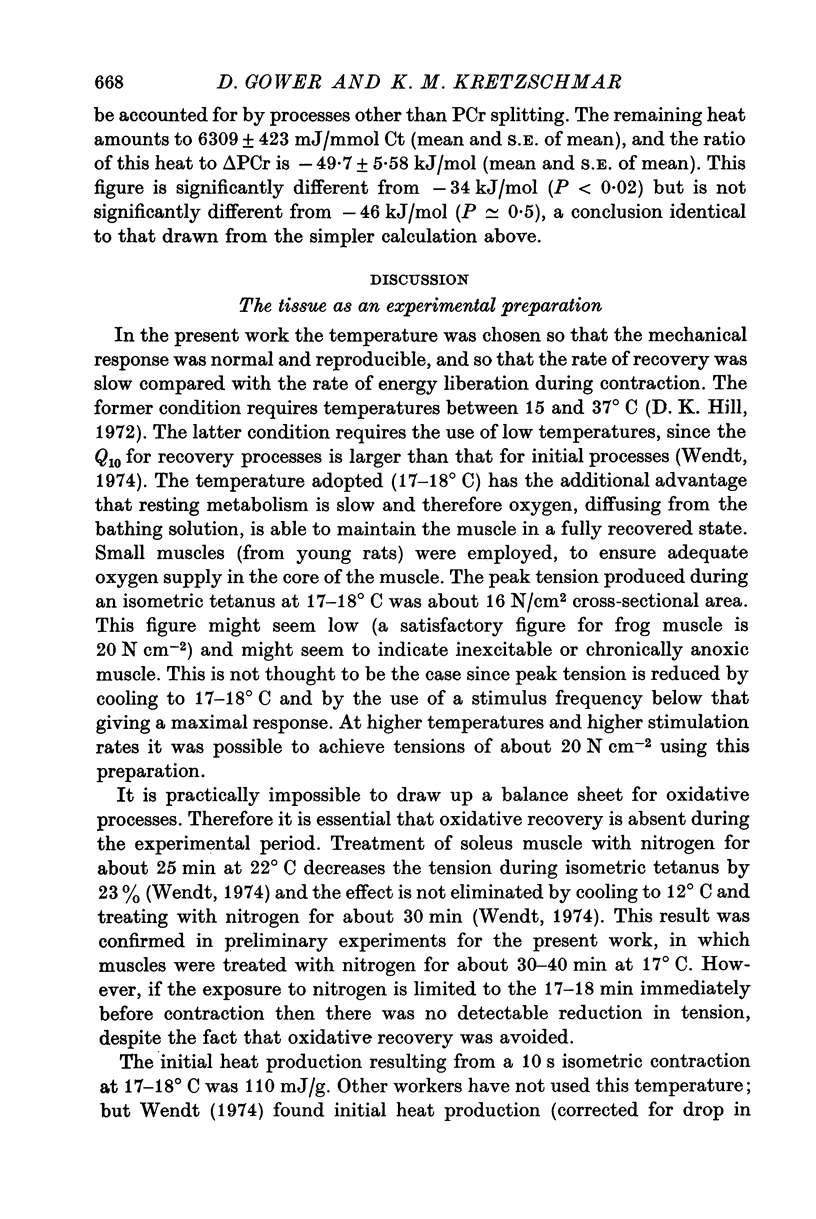
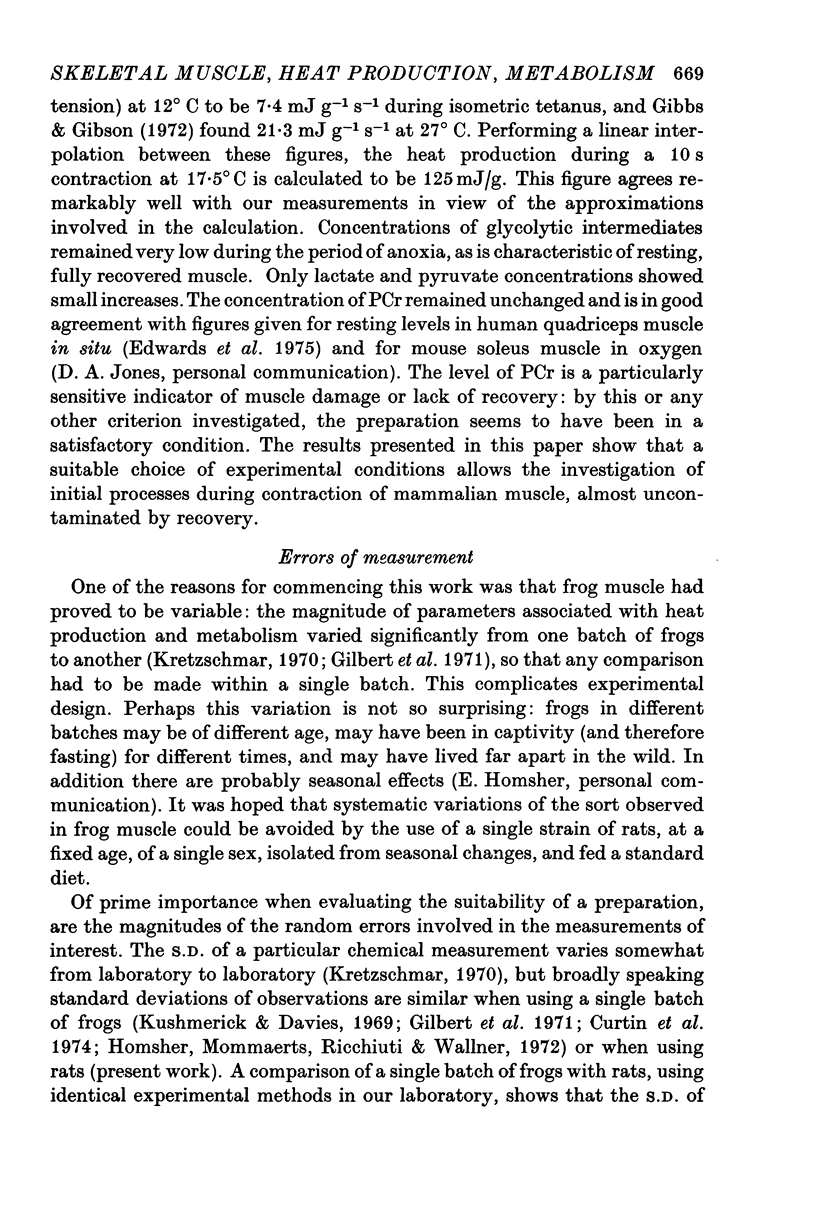
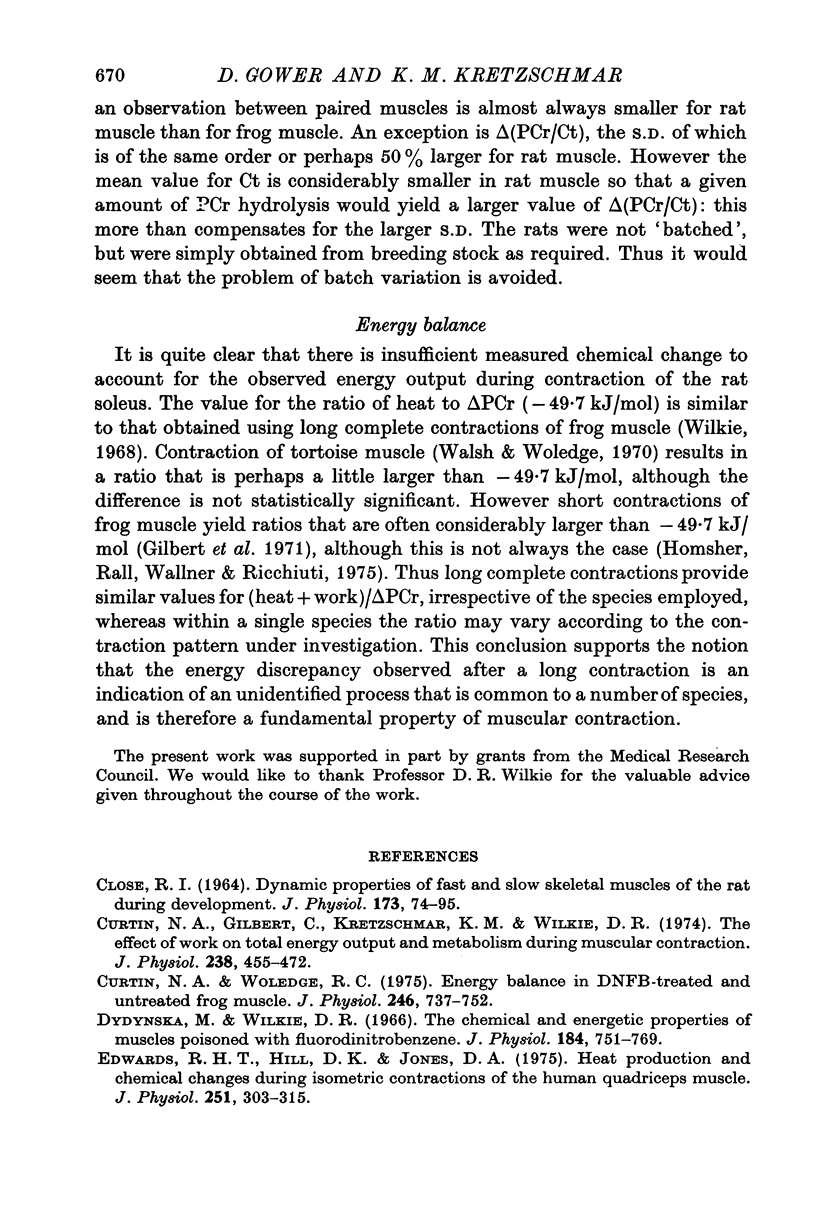
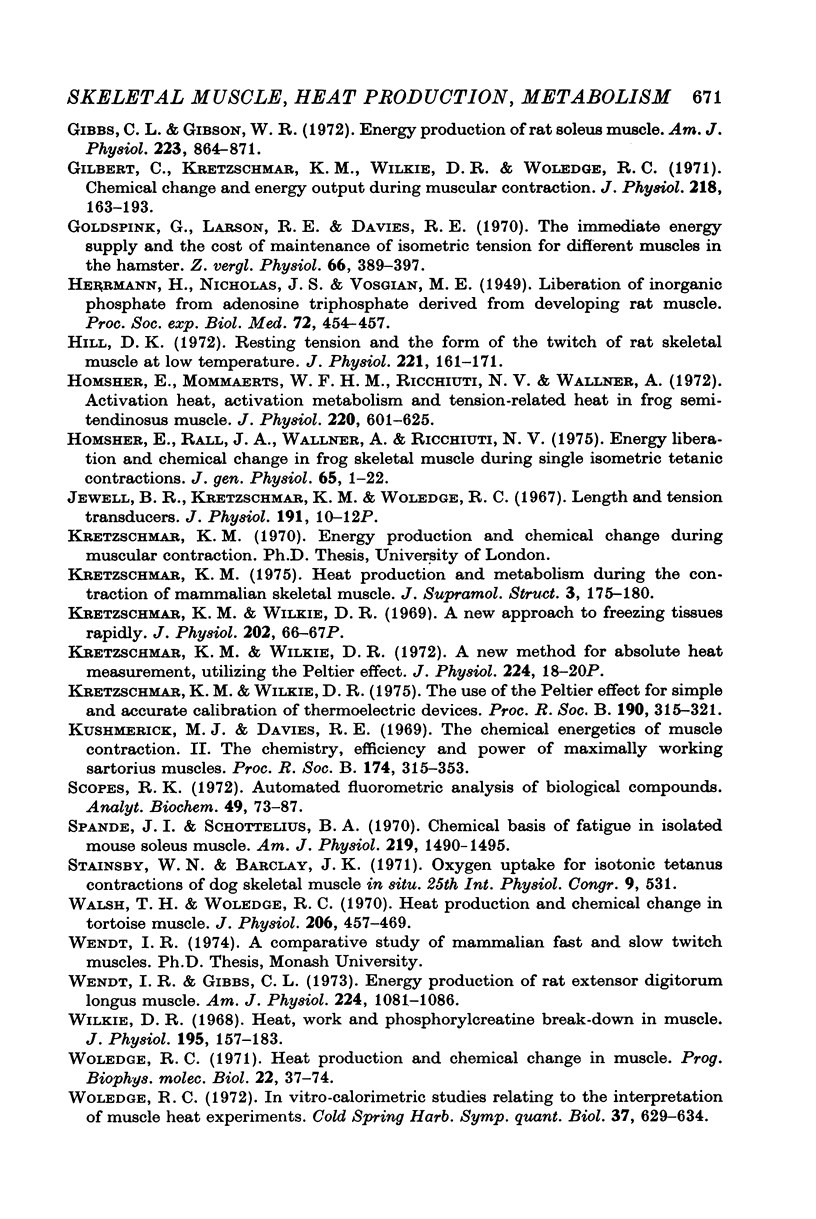
Selected References
These references are in PubMed. This may not be the complete list of references from this article.
- CLOSE R. DYNAMIC PROPERTIES OF FAST AND SLOW SKELETAL MUSCLES OF THE RAT DURING DEVELOPMENT. J Physiol. 1964 Sep;173:74–95. doi: 10.1113/jphysiol.1964.sp007444. [DOI] [PMC free article] [PubMed] [Google Scholar]
- Curtin N. A., Gilbert C., Kretzschmar K. M., Wilkie D. R. The effect of the performance of work on total energy output and metabolism during muscular contraction. J Physiol. 1974 May;238(3):455–472. doi: 10.1113/jphysiol.1974.sp010537. [DOI] [PMC free article] [PubMed] [Google Scholar]
- Curtin N. A., Woledge R. C. Energy balance in DNFB-treated and untreated frog muscle. J Physiol. 1975 Apr;246(3):737–752. doi: 10.1113/jphysiol.1975.sp010913. [DOI] [PMC free article] [PubMed] [Google Scholar]
- Dydyńska M., Wilkie D. R. The chemical and energetic properties of muscles poisoned with fluorodinitrobenzene. J Physiol. 1966 Jun;184(3):751–769. doi: 10.1113/jphysiol.1966.sp007946. [DOI] [PMC free article] [PubMed] [Google Scholar]
- Edwards R. H., Hill D. K., Jones D. A. Heat production and chemical changes during isometric contractions of the human quadriceps muscle. J Physiol. 1975 Oct;251(2):303–315. doi: 10.1113/jphysiol.1975.sp011094. [DOI] [PMC free article] [PubMed] [Google Scholar]
- Gibbs C. L., Gibson W. R. Energy production of rat soleus muscle. Am J Physiol. 1972 Oct;223(4):864–871. doi: 10.1152/ajplegacy.1972.223.4.864. [DOI] [PubMed] [Google Scholar]
- Gilbert C., Kretzschmar K. M., Wilkie D. R., Woledge R. C. Chemical change and energy output during muscular contraction. J Physiol. 1971 Oct;218(1):163–193. doi: 10.1113/jphysiol.1971.sp009609. [DOI] [PMC free article] [PubMed] [Google Scholar]
- HERRMANN H., NICHOLAS J. S., VOSGIAN M. E. Liberation of inorganic phosphate from adenosinetriphosphate by fractions derived from developing rat muscle. Proc Soc Exp Biol Med. 1949 Nov;72(2):454–457. doi: 10.3181/00379727-72-17466. [DOI] [PubMed] [Google Scholar]
- Hill D. K. Resting tension and the form of the twitch of rat skeletal muscle at low temperature. J Physiol. 1972 Feb;221(1):161–171. doi: 10.1113/jphysiol.1972.sp009746. [DOI] [PMC free article] [PubMed] [Google Scholar]
- Homsher E., Mommaerts W. F., Ricchiuti N. V., Wallner A. Activation heat, activation metabolism and tension-related heat in frog semitendinosus muscles. J Physiol. 1972 Feb;220(3):601–625. doi: 10.1113/jphysiol.1972.sp009725. [DOI] [PMC free article] [PubMed] [Google Scholar]
- Homsher E., Rall J. A., Wallner A., Ricchiuti N. V. Energy liberation and chemical change in frog skeletal muscle during single isometric tetanic contractions. J Gen Physiol. 1975 Jan;65(1):1–21. doi: 10.1085/jgp.65.1.1. [DOI] [PMC free article] [PubMed] [Google Scholar]
- Jewell B. R., Kretzschmar M., Woledge R. C. Length and tension transducers. J Physiol. 1967 Jul;191(1):10P–12P. [PubMed] [Google Scholar]
- Kretzschmar K. M. Heat production and metabolism during the contraction of mammalian skeletal muscle. J Supramol Struct. 1975;3(2):175–180. doi: 10.1002/jss.400030211. [DOI] [PubMed] [Google Scholar]
- Kretzschmar K. M., Wilkie D. R. A new approach to freezing tissues rapidly. J Physiol. 1969 Jun;202(2):66P–67P. [PubMed] [Google Scholar]
- Kretzschmar K. M., Wilkie D. R. The use of the Peltier effect for simple and accurate calibration of thermoelectric devices. Proc R Soc Lond B Biol Sci. 1975 Aug 19;190(1100):315–321. doi: 10.1098/rspb.1975.0095. [DOI] [PubMed] [Google Scholar]
- Kushmerick M. J., Davies R. E. The chemical energetics of muscle contraction. II. The chemistry, efficiency and power of maximally working sartorius muscles. Appendix. Free energy and enthalpy of atp hydrolysis in the sarcoplasm. Proc R Soc Lond B Biol Sci. 1969 Dec 23;174(1036):315–353. doi: 10.1098/rspb.1969.0096. [DOI] [PubMed] [Google Scholar]
- Scopes R. K. Automated fluorometric analysis of biological compounds. Anal Biochem. 1972 Sep;49(1):73–87. doi: 10.1016/0003-2697(72)90243-6. [DOI] [PubMed] [Google Scholar]
- Spande J. I., Schottelius B. A. Chemical basis of fatigue in isolated mouse soleus muscle. Am J Physiol. 1970 Nov;219(5):1490–1495. doi: 10.1152/ajplegacy.1970.219.5.1490. [DOI] [PubMed] [Google Scholar]
- Walsh T. H., Woledge R. C. Heat production and chemical change in tortoise muscle. J Physiol. 1970 Feb;206(2):457–469. doi: 10.1113/jphysiol.1970.sp009024. [DOI] [PMC free article] [PubMed] [Google Scholar]
- Wendt I. R., Gibbs C. L. Energy production of rat extensor digitorum longus muscle. Am J Physiol. 1973 May;224(5):1081–1086. doi: 10.1152/ajplegacy.1973.224.5.1081. [DOI] [PubMed] [Google Scholar]
- Wilkie D. R. Heat work and phosphorylcreatine break-down in muscle. J Physiol. 1968 Mar;195(1):157–183. doi: 10.1113/jphysiol.1968.sp008453. [DOI] [PMC free article] [PubMed] [Google Scholar]


